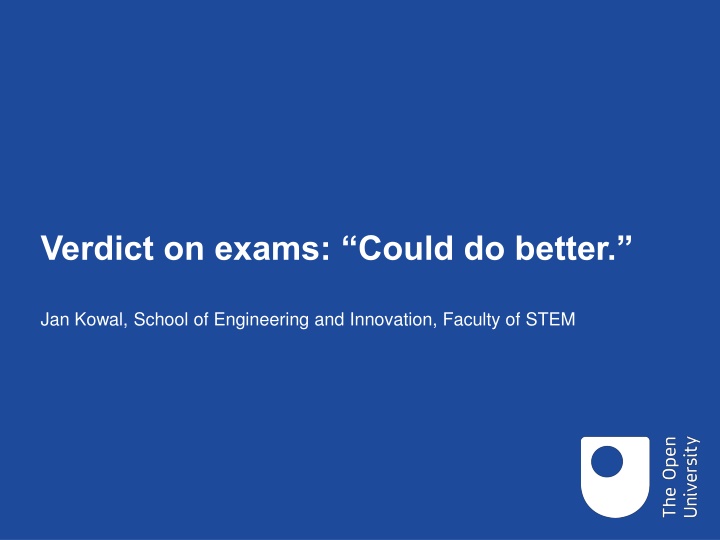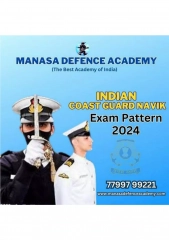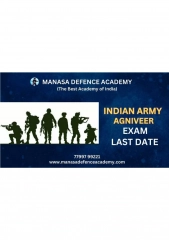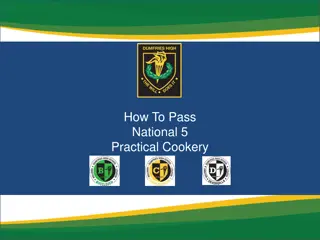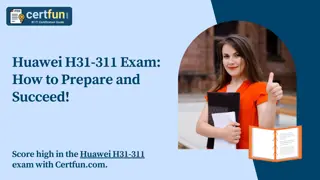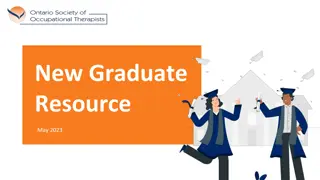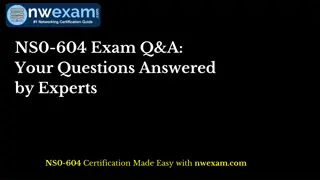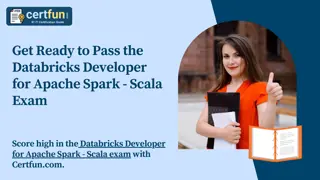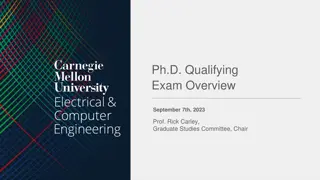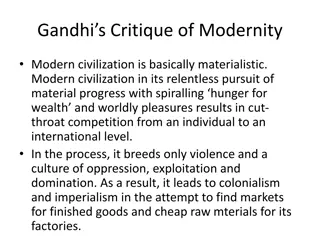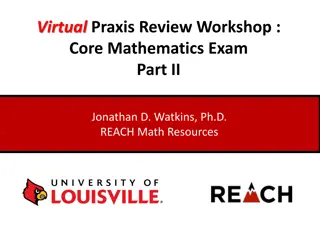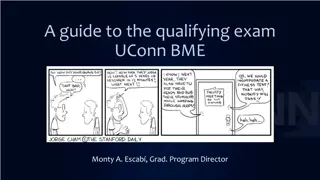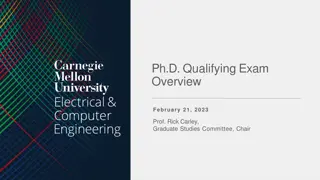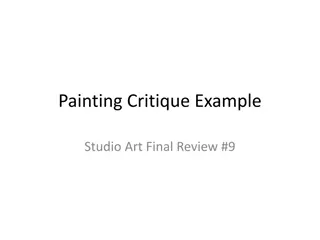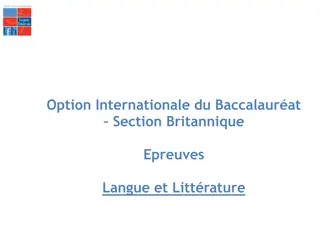Exam Assessment Critique
The discussion delves into the unintended learning outcomes, missed opportunities in exams, arguments against exams, and comparison of assessment methods in education. It questions the effectiveness of traditional exams in evaluating students' true abilities and suggests alternative assessment approaches.
Download Presentation

Please find below an Image/Link to download the presentation.
The content on the website is provided AS IS for your information and personal use only. It may not be sold, licensed, or shared on other websites without obtaining consent from the author.If you encounter any issues during the download, it is possible that the publisher has removed the file from their server.
You are allowed to download the files provided on this website for personal or commercial use, subject to the condition that they are used lawfully. All files are the property of their respective owners.
The content on the website is provided AS IS for your information and personal use only. It may not be sold, licensed, or shared on other websites without obtaining consent from the author.
E N D
Presentation Transcript
Verdict on exams: Could do better. Jan Kowal, School of Engineering and Innovation, Faculty of STEM
Unintended Learning Outcomes Outcome 1: (For most exams): Your ability to switch to writing in an unfamiliar way Outcome 2: Your ability at speed writing Outcome 3: (For some exams): Your ability to memorize and recall under time pressure Outcome 4: Your skill and luck at question spotting Outcome 5: Your exam technique Outcome 6: (For some students only): Your ability to shut out your troubles during an imposed three-hour period, however severe they are Outcome 7: (For some students only): Your faith that you can do exams after all Outcome 8: Your cultural and educational capital. 3
Missed opportunities 1. Set realistic tasks 2. Set rewarding tasks. 3. Exercise and develop self-study skills. 4. Provide useful formative feedback. 4
Summary of arguments against exams The role of the end-of-module examination is to test rather than to teach, whereas assessment by coursework achieves both outcomes. Because of time pressure, examinations do not result in work of academic excellence, whereas assessment by coursework enables students to produce their best work. Examinations require students to demonstrate their knowledge simply through writing, whereas assessment by coursework enables them to express themselves in other ways. Examination anxiety can affect some students performance and sometimes their health, whereas assessment by coursework generates less anxiety. Students academic performance is affected by variations in their physical and mental health, so it is fairer to assess them over a longer time than a brief examination period. Bassey (1971) as cited by Richardson (2015) 5
Module with an unseen exam Module A: Continuous assessment vs Examinable component score 100 90 80 70 R = 0.4487 OCAS 60 50 40 30 20 10 0 0 10 20 30 40 50 60 70 80 90 100 Exam score 7
Module with an End-of Module dissertation Module B: Continuous assessment versus EMA score 100 90 80 70 OCAS 60 R = 0.5734 50 40 30 20 10 0 0 10 20 30 40 50 60 70 80 90 100 EMA score 8
Authentic Assessment collaboration that is similar to that experienced by practitioners or experts in the field simulations of role-play or scenarios; problem tasks that are like those encountered by practitioners or experts in the field; resources (documents, data, etc.) taken specifically from real-world case studies or research; tasks that students find meaningful; examinations taking place in real-world settings; a range of assessment tasks rather than just the traditional ones; demonstration and use of judgment; students being involved in the negotiation of the assessment task; a test of how well the student thinks like a practitioner/expert in the field (i.e. in tune with the disciplinary mind ). (Whitelock and Cross, 2012) 10
Authentic Assessment meaningful aligned to learning outcomes or objectives (which implicitly would be termed as authentic) resources taken specially from real world case studies or research. (Whitelock and Cross, 2012) 11
Comparison of assessment types against five usefulness criteria (Highly abridged and crudely adapted from Race, 2014) Assessment Rating against criteria: Validity (V) Fairness (F) Whodunit? (W) Real world (R) Feedback (Fb) V F W R Fb 1 2 5 2 1 Advantage Disadvantage Traditional exam High on whodunit. Quick to mark. Unfair to many. Poor range of tasks. Little feedback. Poor on depth of knowledge. Little feedback. Hard to design well. Element of luck. Emphasises accurate reading of question. Short answer exam V F W R Fb 3 3 5 3 1 Fairer on writing speed. Breadth of knowledge. Can quickly test a wide range. Can be good where quick decision-making is a LO. Multiple- choice exam V F W R Fb 3 3 4/5 3 3/4 12
Comparison of assessment types against five usefulness criteria (Highly abridged and crudely adapted from Race, 2014) Assessment Rating against criteria: Validity (V) Fairness (F) Whodunit? (W) Real world (R) Feedback (Fb) V F W R Fb 2 1 1/2 2 2/3 Advantage Disadvantage Essay Rewards ability to argue well. Rewards depth of knowledge. Rewards reading around. Breadth and depth. Marking takes long. Writing style too strong an influence. Annotated bibliography V F W R Fb 4 4 4 5 4 Highly dependent on information literacy. Google and Wikipedia too tempting. Strict word limits to prevent too much time spent by student Report V F W R Fb 3/4 3 2-4 4 4/5 Avoids sudden death Can blend collaborative and individual work. 13
Comparison of assessment types against five usefulness criteria (Highly abridged and crudely adapted from Race, 2014) Assessment Rating against criteria: Validity (V) Fairness (F) Whodunit? (W) Real world (R) Feedback (Fb) V F W R Fb 4 3/4 2-4 4 4/5 Advantage Disadvantage Portfolio of evidence Wide range of evidence. Reflective learning. Excellent for whodunit. Allows probing of responses. Long to mark. May reward quantity over quality. Nervousness may affect student. Difficult to guarantee fairness. Assessment long. Drift of assessment standard over the day affects fairness. Oral exam V F W R Fb 3/4 2/3 5 4/5 3/4 Individual presentation V F W R Fb 4 2/3 5 4/5 3/4 Excellent for whodunit. Good for depth of learning. 14
Comparison of assessment types against five usefulness criteria (Highly abridged and crudely adapted from Race, 2014) Assessment Rating against criteria: Validity (V) Fairness (F) Whodunit? (W) Real world (R) Feedback (Fb) V F W R Fb 4 3 3/4 4/5 4/5 Advantage Disadvantage Poster Room for visual and written evidence. Can be hard to make relative judgments. Can be subjective. Artefact V F W R Fb 4 2/3 4/5 4/5 5 Useful as enduring evidence. Competition can be motivating. Fairness can be affected by unseen external help. Can be difficult to weight in relation to other assessments. 15
References Bassey, M. 1971. The Assessment of Students by Formal Assignments. Wellington: New Zealand University Students Association. Race, P. (2014) Making Learning Happen: 3rd edition, London: Sage. ISBN: 978-1446285961 Richardson, J T E. (2015) Coursework versus examinations in end-ofmodule assessment: a literature review, Assessment & Evaluation in Higher Education, 40:3, 439-455, DOI: 10.1080/02602938.2014.919628 Whitelock, Denise and Cross, Simon (2012). Authentic assessment: What does it mean and how is it instantiated by a group of distance learning academics? International Journal of e-Assessment, 2(1) Article 9. 16
